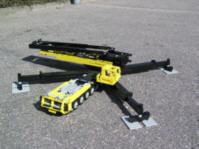
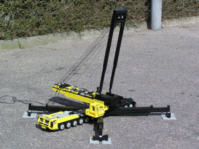
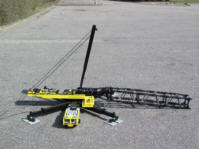
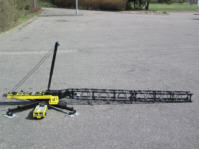
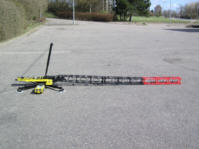
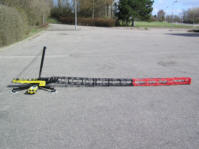
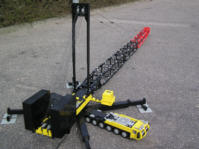
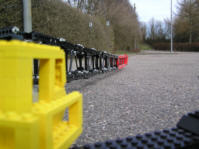
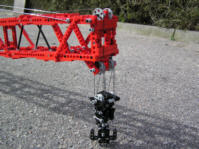
On this site the crane is showed in its first edition with a simple main boom of 2.6 meter.
The first version i have tried to construct is an ordinary main boom of 2.6 meters, which in the scale is compared to 78 meters. I have made a few tests indoor but the crane was too big, so I could not make nice pictures of it, but someday in April the weather was good, and I brought all the parts to a large parking place and assembled the crane to make som tests and good pictures. Regrettably a strong wind came up, and I had to take the crane down quickly to awoid damages.
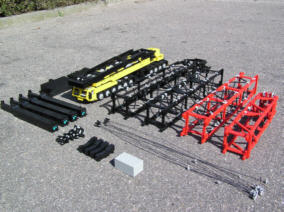
Like a real crane, all of the parts has to be brought to the place where the lift is going to take place. In my
case I had to carry all the parts outside, make sure the light was good and plenty of room to make som good pictures.
The time went fast, and it almost took an hour before the first pictures were taken.
The parts for this setup are:
Chassis with superstructure and A-bracket.
4 outriggers.
4 pad jacks.
8 pad jack boards.
4 counterweights of 1450g each.
1 buttompart of main boom.
3 extensions, 2 black and one red.
1 toppiece of main boom.
10 quy pins.
1 lifting hook.
The first part of the setup is about assembling the crane, first the 4 outriggers, pad jacks and pad jack boards are set in place to give the crane the necessary stability. When the crane is going to lift something high up in the air, it is very important that the chassis is absolutely horizontal. In this case the asphalt was almost horisontal and I tried to raise the crane without an extra plate to place the crane on. But if the cranes should have been higher, it would have been necessary to put it on an horisontal plate.
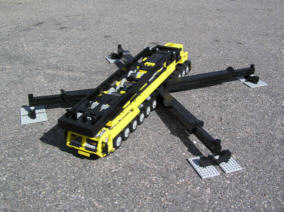
When the chassis is horizontal, the superstructure is swung 90 degrees so it points to the side of the chassis, thereby
it is easier to mount the main boom, it is also possible to mount it over the rear. But in this case I
choose the side. The operators cab, is also swung to its working position.
First the A-bracket is raised to a little above vertical, and an assistant crane helps with the assembling of the single
parts of the main boom.
First part of the main boom is the buttompart, thereafter 2 black extensions of 60 cm, which corrosponds to 18 meters each.
Then a red extension of 60 cm, the reason for using a red sections in the top of the crane is to make it more
visible to airplanes. At last the toppiece with all the rollers for wire is mounted.
When the whole boom is assembled the quy pins is mounted between the end of the A-bracket and the end of the main boom,
when the superlift is not used, it is possible to insert a short quy pin on the middle of the boom, to lower the
load on the long boom.
When the main boom is in place it is time for putting counterweights on the superstructure.
In this case I use 4 counterweights of 1450 g each, total 5,8 kg!
The main boom is raised a little from ground, and the work by putting wires on the lifting hook can take place.
In case of how heavy the load is the more wires is put between the hook and main boom.
Below I have put some pictures which describes the assembly.
 |
 |
 |
 |
 |
 |
 |
 |
 |
The boom is now ready to be raised to the working position, this is done by pulling down the A-bracket by the
strong wires between the A-bracket and superstructure. Then the main boom will raise up in the air.
If the main boom is raised to an almost vertical position, it is sometimes necessary to remove some of the counterweight
again, because the load is getting smaller when the boom is vertical.
Maybe the sharp reader has noticed that the crane is turned 90 degrees on the photoes below, I had to do this because
the wind came up, and to prevent the crane from crashing, I had to make sure the wind came in to the rear of the crane.
Regrettably the background for the pictures was not that good in this direction.
Since I only use a 9V gear motor to raise the boom, it takes a little time. I takes about 8 minutes to raise the
boom to almost vertical position. But the speed is ok, since there is time for controlling the construction to prevent
anything to go wrong. The load of the LEGO is pretty high, and it is necessary to make sure everything is os.
On the pictures you can see how the crane is raised, (and one of the spectators, my parents cat.)
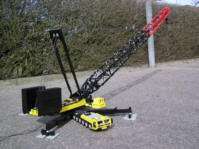 |
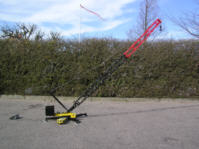 |
|
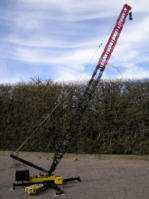 |
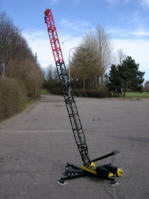 |
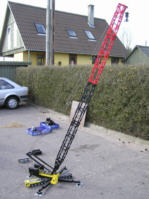 |
|